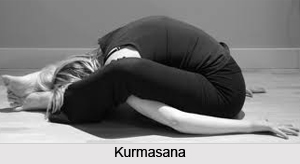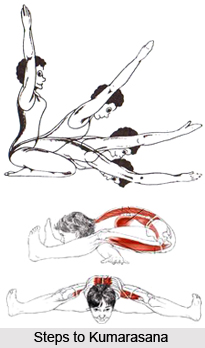 Kurmasana is an advanced yoga posture that putatively prepares the aspirant for Pratyahara, a higher stage in Yoga practice. The asana is highly beneficial to the spine and the abdominal organs. Kurmasana is a seated yoga asana in which the body folds at the waist and the arms slip under the legs. It is recommended to stay in the pose for 30 to 40 seconds and for roughly 5 to 10 breaths. This pose is designed to create inner awareness and relaxation. As a result, Kurmasana is touted as beneficial for relieving stress and improving concentration.
Kurmasana is an advanced yoga posture that putatively prepares the aspirant for Pratyahara, a higher stage in Yoga practice. The asana is highly beneficial to the spine and the abdominal organs. Kurmasana is a seated yoga asana in which the body folds at the waist and the arms slip under the legs. It is recommended to stay in the pose for 30 to 40 seconds and for roughly 5 to 10 breaths. This pose is designed to create inner awareness and relaxation. As a result, Kurmasana is touted as beneficial for relieving stress and improving concentration.
Its name comes from the Sanskrit "Kurma" which means "turtle" or "tortoise", and asana which means "posture". It is so called because the asana resembles the shape of a tortoise in the full pose. Kurmasana may also be known as "Tortoise Pose".
 Practice of Kurmasana
Practice of Kurmasana
In this posture the human body resembles the tortoise. A sequential process for the practice of Kurmasana follows:
Sit with legs wide apart. Place the hands on the thighs.
Inhaling, slightly bend the knees.
Exhaling fully, bend the upper body forward from the hips. With palms facing down slide the arms under the knees from inside the legs.
Slowly bend the upper body further forward until the chin and the chest touch the floor.
Stretch the arms backwards as far as possible. The legs should be bent as little as possible.
Breathing normally hold this position.
Inhaling return to the starting position.
Effects of Kurmasana
Traditionally, Kurmasana is designed to quiet the nervous system and shut out distractions, allowing the inner world to become clear and audible. The mind then becomes quiet and centred. This asana activates the internal organs and is particularly helpful for problems in the lower abdomen. It refreshes the whole body, stimulates the solar plexus and helps to dispel depression. The Asana promotes mobility of the hips and stretches the back and leg muscles.
The Kurmasana is considered sacred to the Yogi as it resembles an avatar of Lord Vishnu. It is reputed to prepare the yogi for "Pratyahara", a higher stage in yoga practice.
Precautions in practice of Kurmasana
Kurmasana is an advanced Asana and should be performed slowly with control. One should always work within their own capacity. Never move in a painful manner or overexert them trying to reach the ground. Never over strain and inhale and exhale normally. Avoid this Asana with problems of the shoulder, elbow or hips.
Kurmasana forms part of the primary series of Ashtanga yoga and is popular in a range of styles of yoga because of its physical and mental benefits.




















